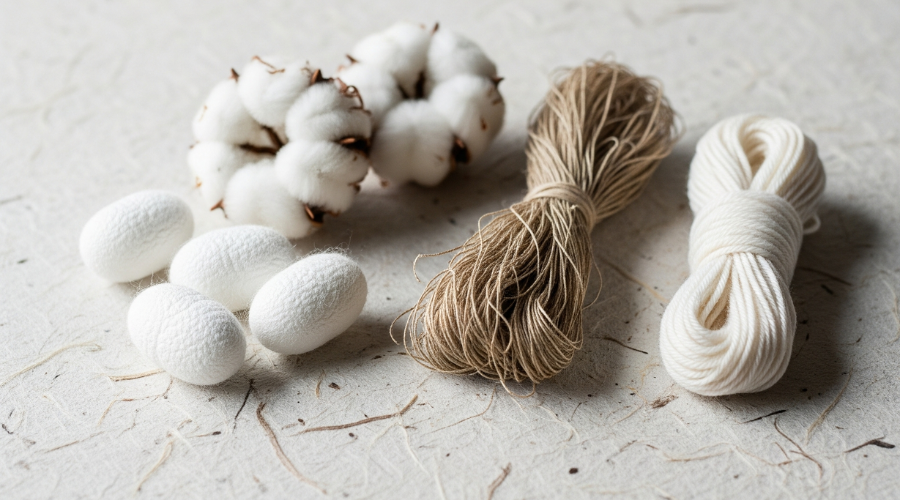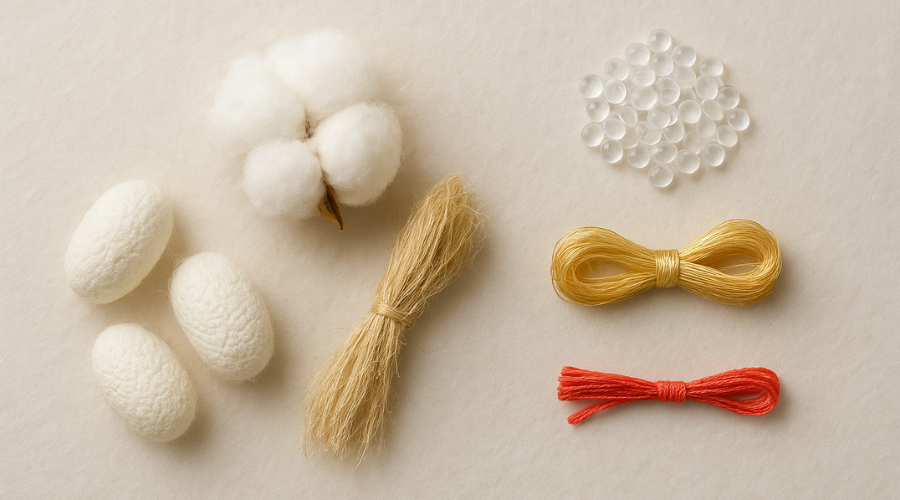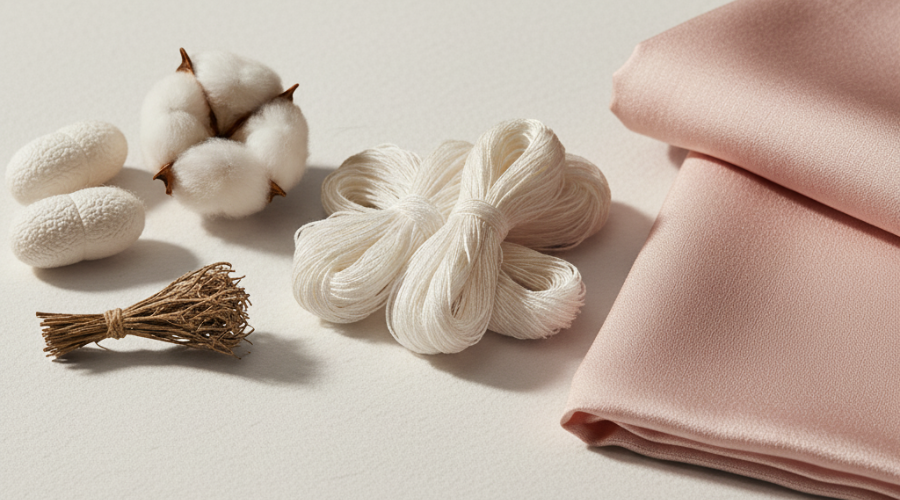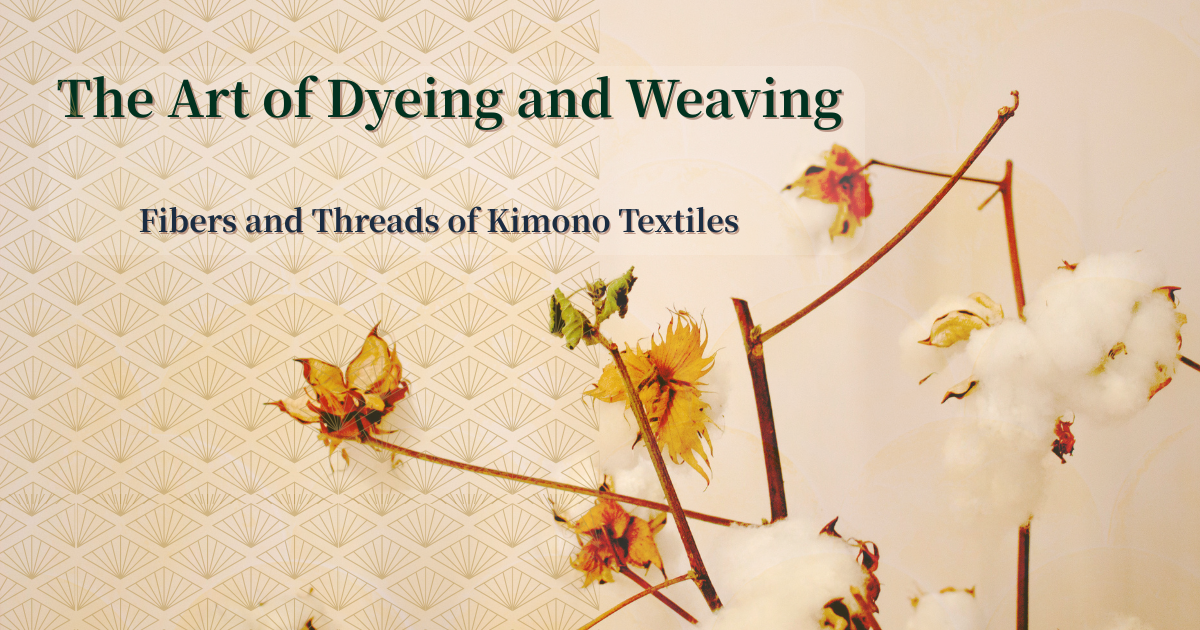The beauty of a kimono is not defined by its patterns or colors alone.
In fact, the type of thread used to weave the fabric greatly influences how the kimono feels on the body, how durable it is, and even how elegant it looks when worn.
As a professional kimono dresser, I have handled countless bolts of fabric and customers’ cherished kimonos over the years.
Through this experience, I’ve learned that two fabrics may look alike, yet be completely different inside.
Even among silk fabrics, the kind of thread, the degree of twist, and the method of refining can change how smoothly it drapes, how easily it wrinkles, and how well it can be stored.
In this article, I’ll share what I’ve learned through hands-on experience—explaining how to identify fabric types, threads, and textures in a way that’s easy for beginners to understand.
Together, let’s develop an eye for quality so you can choose a kimono that you’ll truly love—and never regret.
Rethinking Silk: A Professional’s Guide to Understanding Threads and Fibers

Do you believe that all silk is the same—and all of it is luxurious?
In reality, there are two very different types of silk threads, each with its own personality.
One is the smooth and lustrous filament silk, made from long continuous fibers.
The other is the soft and fluffy staple silk, spun from shorter fibers.
After handling countless fabrics as a professional kimono dresser, I’ve come to realize that this difference in thread type plays a major role in how comfortable a kimono feels and how well it holds its shape.
Once you begin to notice the subtle “expression” of each fiber—something invisible to the eye—the world of kimono fabric selection opens up in entirely new ways.
Not All Silk Is the Same: The Truth Behind Sheen and Softness
Filament Silk (Long Fiber)
Filament silk is made from a single, continuous fiber—typical of silk and many synthetic fibers.
Because the thread is drawn out in one long strand directly from the cocoon, it has a natural sheen and an exceptionally smooth surface.
It glimmers like the surface of still water, and its touch is sleek and fluid, as if it gently slips through your fingers.
💡 From a Kimono Dresser’s Experience
One drawback of this type of fabric is that it slides too smoothly during dressing.
Without proper padding, the hem and collar can easily loosen with each movement, leading to the kimono losing its shape.
To prevent this, I always place small pieces of absorbent cotton in certain “slippery spots” that are unique to long-fiber silks.
These are typically around the collar and shoulder areas, where the roundness and fit are most important.
This simple trick can completely eliminate the stress of a slipping kimono.
It may seem like a minor adjustment, but it keeps the silhouette stable and subtly transforms the overall appearance.
For a detailed, step-by-step guide on how to use absorbent cotton and where it works best, see [Pro Tips: How Absorbent Cotton Can Transform the Fit of Your Silk Kimono].
Staple Silk (Short Fiber)
Staple silk is made from shorter fibers, much like those used in cotton, wool, or tsumugi (pongee silk).
It has a soft, cozy warmth and captivates more through its texture than its shine.
💡 From a Kimono Dresser’s Experience
Kimonos made with staple fibers are highly absorbent and comfortable to wear for long hours, as they don’t trap humidity easily.
However, the trade-off is a much higher risk of moth damage during storage.
At home, whenever I store cotton, wool, or tsumugi kimonos, I always include moisture absorbers and make sure to air them out twice a year.
This small bit of care helps preserve their beautiful texture for many years to come.
Overlooked Synthetics: The Unexpected Ally of Kimono Fabrics?
When people hear the term “synthetic fiber,” they often think of something cheap or artificial.
Yet in reality, many modern synthetic fibers possess a luster and texture that rival silk.
Once you learn how to handle them properly, they can become reliable companions in your kimono life.
Typical examples include polyester, rayon, and acetate—regenerated or semi-synthetic fibers that can beautifully mimic the look and feel of natural silk.
By adjusting the cross-sectional structure of the fibers, manufacturers are able to recreate silk’s smoothness and elegant drape.
It’s often difficult to distinguish them by surface sheen or touch alone, since many fabrics today are blended as “silk mixes” or “synthetic weaves.”
Being able to tell the difference makes a remarkable improvement in how accurately you choose your kimono fabric.
Polyester
Polyester is highly durable and resistant to wrinkles and water, making it one of the strongest allies in modern kimono life.
Its affordability and ease of home washing are also major advantages.
However, over the years, I’ve seen many customers struggle with kimono slippage when wearing polyester fabrics.
The main causes are “excessive smoothness” and “static electricity.”
[Professional Tips to Prevent Kimono Slippage]
- Anti-slip measures:
To prevent the kimono from loosening, I make small adjustments using specific accessories.
For example, I use a Korin belt to keep the collar in place, replace cords with muslin ties, and sometimes add an anti-slip one-touch tape by Itatsu.
These methods aren’t perfect, but they significantly help maintain the kimono’s shape. - Static electricity control:
During dry seasons, static buildup can cause the kimono or undergarments to cling to the body.
In such cases, using an anti-static spray is very effective.
Rayon (Regenerated Fiber)
Rayon is a moisture-absorbent fiber that offers a silky luster and a graceful drape similar to pure silk.
Because of this, it’s popular among those who seek an elegant look at a more affordable price.
However, rayon is a material that even professionals handle with the utmost care when it comes to water exposure.
【Cautions and Emergency Measures】
- Hardening and Shrinkage Due to Water:
When rayon gets wet, its fiber structure collapses. Once it dries, the fabric becomes stiff and rough, often shrinking drastically.
This can easily lead to irreversible damage that can’t be corrected by ordinary stain removal or washing. - Emergency Treatment:
If your rayon kimono accidentally gets wet outdoors, never rub the wet area.
(For white or light-colored fabrics, rubbing may also cause color transfer.)
Instead, gently blot the wet part with a handkerchief or small towel, pressing lightly on both sides to absorb the moisture.
⚠️ Caution:
If the wetting is minor, quick response will usually prevent serious damage.
However, if water soaks deeply into the fabric, it’s best to take the garment to a professional cleaner after performing the emergency treatment.
Acetate (Semi-Synthetic Fiber) & Triacetate (Semi-Synthetic Fiber)
Acetate
Acetate is an attractive material that offers silk-like luster and luxury at an affordable price.
It also has a degree of water repellency, which helps ease concerns about water exposure and adds a sense of reassurance.
[Recommendations and Solutions from a Kimono Dresser]
- Issue: Prone to Wrinkling
The biggest drawback of acetate is that it tends to wrinkle easily while being worn.
To prevent this, I use a commercially available anti-wrinkle spray before going out.
While it’s not a perfect fix, it helps minimize wrinkling and allows the kimono to retain its elegant appearance for everyday wear.
Triacetate
In addition to the luxurious texture of acetate, triacetate enhances practicality with greater water resistance and a remarkable resistance to wrinkling.
[Why It’s Worth Choosing]
The strengths of triacetate lie in its durability against wrinkles and its cool, comfortable feel.
- Ideal for Summer Kimonos:
Its cool touch and light texture help reduce the stuffiness often associated with kimono wear, making it one of the best choices for summer outfits or undergarment blends. - If You Notice Wrinkles:
For minor wrinkles, gently place a cloth over the area and iron it at a low to medium temperature (around 80–120°C).
Avoid using steam mode on the iron.
Types and Classifications of Fibers: The Difference Between Natural and Synthetic

In fact, many failures in kimono care stem from a fundamental misunderstanding of differences in fabric materials.
Fibers are broadly divided into two categories: natural fibers (such as silk and cotton) and synthetic fibers (such as polyester and rayon).
The distinction between these two goes far beyond price or texture.
Because their main components—their very chemical structures—are fundamentally different, they react to water and heat in completely opposite ways, which greatly affects how they should be cared for.
In modern kimono life, the key is learning how to make synthetic fibers—which are wrinkle-resistant, lightweight, and durable—work to your advantage.
In this section, I’ll explain both the “unique personalities” of natural and synthetic fibers and the “hidden strengths” of synthetics, based on the materials I actually handle in my work.
Natural Fibers: Materials Derived from Animals, Plants, and Minerals
Characteristics of Natural Fibers
Natural fibers are known for their excellent moisture absorption and breathability, making them comfortable and gentle on the skin.
They have long been used as kimono materials, harmonizing beautifully with Japan’s changing four seasons and the natural sensitivity of the human body.
Types of Natural Fibers
●Animal Fibers
Natural fibers are broadly divided into animal fibers and plant fibers.
Animal fibers are made by animals and consist mainly of protein.
They are supple and have excellent heat retention properties.
- Silk:
A fiber made from cocoons produced by domesticated silkworms or wild varieties.
It has a beautiful natural sheen and is one of the most luxurious materials used for kimono. - Wool:
Includes sheep’s wool, cashmere, alpaca, camel, and angora.
These fibers are soft, warm, and pleasant to the touch.
| Material | Examples |
|---|---|
| Silk | Domesticated (cultivated) silkworms, wild silkworms |
| Wool | Sheep’s wool, cashmere, alpaca, camel, angora, etc. |
●Plant Fibers
Plant fibers are derived from plants and consist mainly of cellulose.
They are breathable and have a light, crisp texture that feels refreshing on the skin.
- Seed Fibers:
Cotton and kapok. These fibers have excellent moisture absorption and are widely used for yukata and other casual wear. - Bast Fibers:
Ramie, jute, vine, hemp, and Manila hemp.
These fibers have natural stiffness and firmness, making them ideal for high-grade summer kimono and obi fabrics. ⚠️ Caution:
Most linen fabrics—especially ramie and hemp—tend to become stiff or rough (gowa-tsuki) after wrinkling or exposure to water, so careful handling is required. - Fruit Fibers:
Coconut (palm) fibers, etc. - Others:
Paper mulberry (kōzo) and rush (igusa), which are also used in Japanese paper and tatami coverings.
| Type | Examples |
|---|---|
| Seed Fibers | Cotton, kapok |
| Bast Fibers | Ramie, jute, vine, hemp, Manila hemp |
| Fruit Fibers | Coconut (palm) |
| Others | Paper mulberry (kōzo), rush (igusa) |
Note: There are also mineral-based fibers (such as asbestos), but since they are not used for kimono or clothing purposes, they are omitted here.
Chemical Fibers (Regenerated and Synthetic): Fibers Created Through Chemical Processing and Synthesis
Characteristics
Chemical fibers are wrinkle-resistant, lightweight, and durable.
They are easy to care for and have been developed to suit modern lifestyles.
Types of Chemical Fibers
Chemical fibers are generally classified into three categories:
regenerated fibers, semi-synthetic fibers, and synthetic fibers.
Each type has its own characteristics and is used as material for kimono and obi fabrics.
💡 Note:
In recent years, blended fabrics—which combine natural and chemical fibers—have become increasingly common for kimono.
These blends take advantage of the strengths of both types of fibers, offering wrinkle resistance, durability, and more affordable pricing.
●Regenerated Fibers (Cellulose-based)
These are fibers made by dissolving natural raw materials such as wood pulp and then reforming them into fibers.
Because their luster and texture resemble silk, they are sometimes called “artificial silk.”
👉 Examples: rayon, cupro, polynosic
●Semi-Synthetic Fibers
These are made by chemically processing naturally derived substances such as cellulose or proteins.
They are engineered to enhance strength and colorfastness, and are sometimes used in traditional accessories for kimono.
👉 Examples: acetate, triacetate, Promix
●Synthetic Fibers
These are fully artificial fibers chemically synthesized from raw materials such as petroleum or natural gas.
They are light, strong, and resistant to wrinkles, which makes them widely used in everyday kimono and linings.
👉 Examples: nylon, polyester, acrylic, vinylon (Kuraray/Unitika)
Basics of Fibers and Threads | What Shapes a Kimono

Kimono fabrics are made from two types of fibers with completely opposite reactions to water and heat —
natural fibers such as silk and cotton, and chemical fibers such as polyester and rayon.
Understanding the basics of these fibers—and the threads spun from them—is the key to knowing how to care for your kimono properly.
In the following section, we’ll take a closer look at the hidden world behind kimono fabrics,
explaining in simple terms how fibers are produced and how the thickness of threads affects the fabric’s texture and quality.
Classification by Thread-Making Method | Three Ways Threads Are Created
Threads can be broadly divided into three categories based on how they are made.
Some, like silk, are taken directly as raw filaments.
Others, like synthetic fibers, are artificially produced.
And still others, like cotton or wool, are created by twisting together short fibers into thread.
| Type | Description | Kimono Examples |
|---|---|---|
| Reeled Thread | Extracting raw filaments (silk) | Silk threads used for komon, homongi, and tsukesage |
| Filament Thread | Artificially manufactured chemical fibers | Washable polyester kimono, synthetic nagajuban |
| Spun Thread | Twisting short fibers into yarn (cotton, wool, etc.) | Cotton yukata, everyday wool kimono |
Furthermore, one of the unique charms of kimono is the use of gold and silver threads woven into the obi, which are essential for expressing elegance and formality.
From casual cotton and wool, to formal silk kimono, and even the most prestigious obi—the types of threads and their methods of production shape the very form of the kimono and enrich the beauty of our attire.
Units of Yarn Thickness | The Numbers That Define Fabric Texture
Yarn has specific units to indicate its thickness, and these differences greatly influence the texture and feel of kimono fabrics.
| Unit | Description | Image in Kimono Use |
|---|---|---|
| Denier (D) | A unit that measures the thickness of long fibers (filament yarn). The larger the number, the thicker the yarn. | Used in polyester kimono and nagajuban (long undergarments). Thicker yarn is stronger with firmness, while thinner yarn is softer and more supple. |
| Cotton Count (S) | A unit that measures the thickness of spun yarn (cotton, wool, etc.). The larger the number, the finer the yarn. | Used in cotton yukata and wool kimono. Finer counts feel light and smooth, while coarser counts give a casual, sturdy impression. |
💡 Key Point
Even within the same type of kimono, the thickness of the thread changes the fabric’s luster, weight, and comfort.
In other words, the numerical value of thread thickness directly translates into a difference in the look and feel of the kimono.
About Twisted Threads (Nenshi)
Yarn is not simply bundled together; by adding a twist, its strength and texture can be adjusted. This process is called nenshi (twisted yarn).
The characteristics of twisted yarn vary depending on the direction and number of twists applied.
- S-twist (right-hand twist): Twisted clockwise, resembling the letter S
- Z-twist (left-hand twist): Twisted counterclockwise, resembling the letter Z
The more twists added to a yarn, the firmer it becomes, creating a crisp and dry texture. With fewer twists, the yarn remains soft and fluffy.
In kimono textiles, these variations in twisted yarn play a significant role in determining the overall texture and feel of the fabric.
| Twist Strength | Approx. Twist Count (per meter) | Characteristics |
|---|---|---|
| Low twist (ama-nenshi) | ~300 or fewer | Soft and fluffy (e.g., gauze) |
| Normal twist (nami-nenshi) | ~1000 or fewer | Standard twist for general use |
| High twist (kyo-nenshi) | ~1000 or more | Firm texture with a crisp feel |
Examples of Use
- Strongly twisted yarn (kyōnenshi): Often used for summer kimono and yukata to create a crisp, cool texture.
- Twisted yarn: Utilized in fabrics such as tsumugi and omeshi to achieve their distinctive firmness and textured surface.
- Softly twisted yarn (amanenshi): Sometimes applied to gauze-like linings to emphasize softness.
In this way, the degree of twist alone can dramatically change both the appearance and the comfort of a kimono.
●Types of Twisted Yarn
| Type | Description | Features / Common Uses |
|---|---|---|
| Single Twist Yarn (Katayori-ito) | Made by twisting one or several single threads in the same direction | Creates soft fabrics, often used for casual kimono fabrics such as komon and everyday wear |
| Double Twist Yarn (Moyori-ito) | After an initial twist, several threads are combined and twisted again in the opposite direction (e.g., koma-yori, kata-yori) | Produces strength, crisp texture, and firmness. Frequently used in summer kimono (such as ro and sha) and in formal obi fabrics |
| Others | Special twisting methods: koma-yori (strong twist for crispness), kata-yori (firm, balanced twist), decorative twists (for ornamental design) | Commonly used in obi and high-grade fabrics, or in kimono where design emphasis is important |
Note: The classification and twist count guidelines are based on information provided by the Japan Textile Products Quality and Technology Center .(QTEC, 一般財団法人 日本繊維製品品質技術センター).

The way a thread is twisted can greatly affect its texture and intended use. Let’s take a look at the differences between the two main types: S-twist and Z-twist.
What Is Seiren (Degumming)?
Raw silk, the original form of silk threads, contains two main components:
- Fibroin – the fiber that makes up the silk itself
- Sericin – a protein that surrounds the fibroin
The process of removing sericin and other impurities is called Seiren (degumming).
Through degumming, silk regains its natural softness and beautiful luster, resulting in a refined and luxurious texture.
● Classification by the Timing of Degumming
Silk fabrics can be divided into two types depending on when the degumming process is carried out.
| Type | Method | Characteristics |
|---|---|---|
| Pre-degummed fabrics (Sakineri-ori-mono) | The silk thread is degummed before weaving | Enhances the luster and softness of the silk, resulting in a smooth finish |
| Post-degummed fabrics (Atoneri-ori-mono) | The fabric is woven first and then degummed | Leaves firmness in the fabric, making it easier to bring out a three-dimensional texture in the weave |
Kimono-Specific Examples
- Pre-degummed (Sakineri): Luxurious fabrics such as chirimen (crepe) and patterned weaves, valued for their softness and sheen.
- Post-degummed (Atoneri): Fabrics like habutae (silk plain weave) and hakama cloth, which retain firmness and structure.
In high-grade woven textiles, the choice of degumming method greatly influences the final finish, making this process especially important.
Summary
The “fibers” and “yarns” are what determine the texture, feel, and functionality of a kimono.
By understanding the differences in materials, you can also learn how to care for them properly and recognize the occasions where each type is most suitable.
For example, a soft silk komon, a sturdy cotton kimono for everyday wear, or an ornate obi woven with shimmering gold threads…
Once you know the characteristics of different fibers and yarns, choosing kimono becomes even more enjoyable.
Step by step, as you learn the basics of weaving and dyeing, you can connect with Japan’s textile culture through an experience of knowing, touching, and enjoying.
✿Column: Fumi’s Kimono Diary ✿
The other day, I went out wearing one of my favorite komon.
As I glanced at my sleeve, I suddenly wondered, “Which twist is this thread… S-twist? Or Z-twist?”
To others, I must have looked like someone completely immersed in the world of kimono (laughs).
Of course, whether it’s an S-twist or Z-twist doesn’t drastically change how it feels to wear in daily life.
But when I notice those little differences, the kimono no longer feels like “just clothing” to me—it becomes a fabric with its own story.
Every single thread holds history and craftsmanship, and by learning about it, I feel just a little closer to kimono.
For me, that tiny realization is the most delightful reward.


